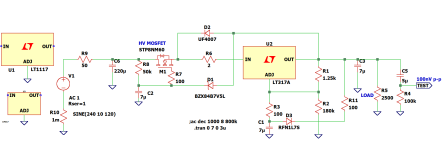Yes, this design is not optimised for a power amp. I have used something similar in two DHT amps, P-P 211 and 811, the latter with a choke input. This was 30 years ago, using HV BJT's.
Using R in series is no worse than the R of an inductor, it will knock out a few dB of ripple.
Run the sim, I see at least 120dB of ripple rejection.
Efficient? No, neither are vacuum tubes. Wasted kWh won't add to a hill of beans.
Low dropout not an issue with sufficient head voltage. LM317 need an extra ~2.5V dropout, which is not much at 80mA. The LM1117 is better, but watch that stability with capacitive loading. A series resistor to the output cap may be needed depending on the caps ESR.
Using R in series is no worse than the R of an inductor, it will knock out a few dB of ripple.
Run the sim, I see at least 120dB of ripple rejection.
Efficient? No, neither are vacuum tubes. Wasted kWh won't add to a hill of beans.
Low dropout not an issue with sufficient head voltage. LM317 need an extra ~2.5V dropout, which is not much at 80mA. The LM1117 is better, but watch that stability with capacitive loading. A series resistor to the output cap may be needed depending on the caps ESR.
Hey Andy, copy me on your PS ccts, I'll rum them in EWB, see what we get. THX, JLSAndy if you give me schematics of each PSU I'm glad to help you simulating with PSUDII.
The LT1117 (and LM1117?) are not much better than the vanilla LM317 model I have, however the LT317A, which also is an LDO (not needing heatsink here) is a few dB better, and 10dB more money.
I changed D7 to lower leakage type and added a series resistor to limit discharge current.
I'm wondering if putting a series R to ground (R10) may be worth it to reduce hard rectifier current into ground. I may have to use real parts to find out.
I changed D7 to lower leakage type and added a series resistor to limit discharge current.
I'm wondering if putting a series R to ground (R10) may be worth it to reduce hard rectifier current into ground. I may have to use real parts to find out.
